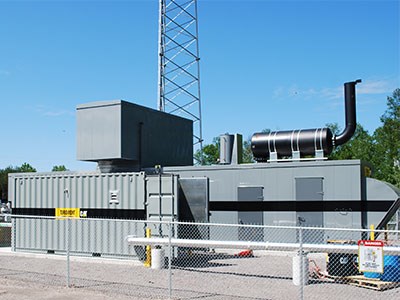Only in Northern Ontario would distance, remoteness and bears prove to be a challenge for a landfill gas power generation plant.
But despite the obstacles, the Merrick landfill plant, located off Highway 11 North, 26 kilometres from city hall, is successfully converting methane gas into electricity.
The plant is owned and operated by North Bay Hydro and is generating 1.6 megawatts, enough to power about 1,000 homes for a year.
“It is a commercial project with a very strong financial return,” said Todd Wilcox, chief operating officer of North Bay Hydro.
It is connected to the grid and is part of the province's Feed-in tariff (FIT) program.
A methane collection system had already been in place at the landfill site since 2004 to burn off the gas, but the project faced many hurdles over the past four years to get it operational last summer.
“The landfill is in the middle of nowhere and connecting it to the electrical system was certainly a challenge,” he said. “And we had to communicate with the plant so that was a challenge too.”
The approval process took four years and it is the first landfill gas project that was approved under the new environmental regulations.
“We went through a very extensive and expensive environmental approval process,” Wilcox said. “It took us 18 to 24 months to just get approval for a generator in the middle of a landfill, in the middle of nowhere.”
To operate the plant remotely, communicating with it proved to be a challenge due to its distance and location from the city.
“The terrain is pretty rugged and we had to have instantaneous control,” he said. “We have to be able to turn the generator off at an instant's notice.”
A radio signal is used and a 200-foot high tower had to be built at the landfill. The radio signal is bounced off a water tower near the airport and then bounced over to an electrical substation in the city.
“We had to figure all that out and make sure it works.”
Bears destroyed part of the methane collection system by stomping on the wells drilled on the landfill.
“They challenged the construction of the well heads and they won,” Wilcox said. “So, we had to change that around so they don't win any more.”
While North Bay Hydro did a lot of the electrical work, outside contractors were also hired. A 20-cylinder, 2,000 HP diesel engine was modified to burn on landfill gas. The cylinders were reinforced to withstand the corrosiveness of the gas.
Since the plant was installed, the amount of methane actually produced has been stabilized.
“The landfill is almost like an organism and it has developed a real personality,” he said. “It doesn't like dry weather, it doesn't like super hot weather. When it is wet, it produces a lot more gas. So the plant reacts to its personality and we vary production to match what is happening. We are always looking at the weather.”
Other communities have visited the project to gain insight but most landfills won't have the connection and communication problems the Merrick site did.
“To develop a project like this is not for the faint of heart,” Wilcox said. “You have to understand the environmental approval process and also understand electrical systems and how to connect them up in remote areas. You also have to understand the communication challenges and how to get over those problems.”
The $4-million project came in 17 per cent under budget and began producing power in June, 2012.
It has a solid economic return, but environmentally, it's a great project, he said.
“This, to me, is where renewables play a great role. Either we use the methane or we cause significant environmental harm. This is where we should be applying the technology and spending most of our time, I believe.
“It produces electricity 24 hours a day and is not intermittent like wind or solar. It is reliable and it actually helps to stabilize voltage in the system. It's a wonderful project.”




